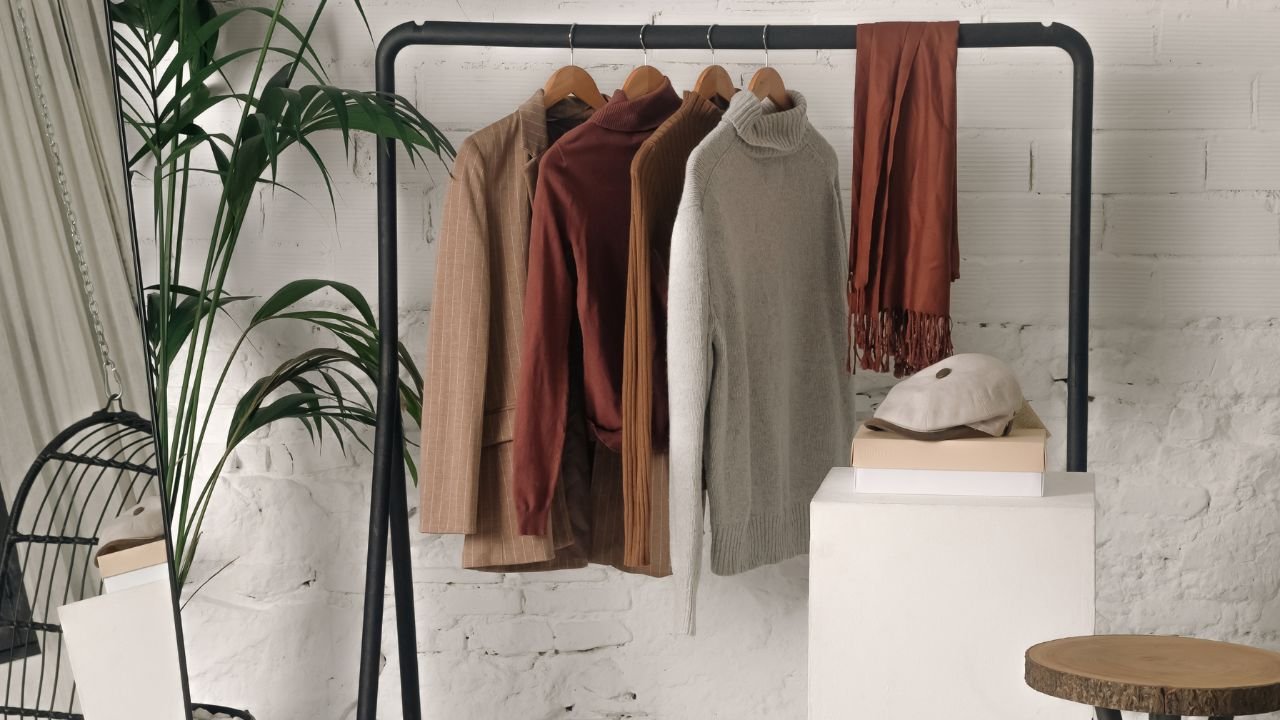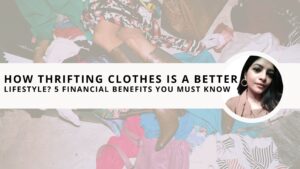Have you ever wondered how your fashion choices impact the planet? Imagine starting each day by putting on clothes that not only make you look good but also make you feel good about your choices. This isn’t just a dream; it’s the reality of what is sustainable fashion.
Sustainable fashion is more than just a trend; it’s a vital movement that aims to reduce the environmental impact of the fashion industry. It represents a shift away from the harmful practices of fast fashion toward a more mindful approach to what we wear.
Before we dive deeper into sustainable fashion, let’s look at what we’re moving away from.
The fast fashion industry is a major contributor to the climate crisis, accounting for up to 10% of worldwide carbon dioxide emissions. It relies on cheap materials and labor to produce clothing at an alarming rate, all to keep up with rapidly changing trends.
Sound familiar?
We’ve all been there: buying a trendy piece, wearing it a few times, then discarding it when the next trend comes along. But this cycle comes at a significant cost to our planet.
That’s where sustainable fashion enters the picture, offering a better way forward for both style enthusiasts and the environment.
What is Sustainable Fashion?
What is sustainable fashion? It’s an approach to clothing production and consumption that prioritizes environmental sustainability and social responsibility. To fully grasp this concept, we should first understand what sustainability means in a broader context.
According to the United Nations, sustainability means “meeting the needs of the present without compromising the ability of future generations to meet their own needs.” In simpler terms, it’s about taking care of what we have today so that future generations will have what they need tomorrow.
In the fashion world, this translates to practices that:
- Reduce Environmental Impact: Sustainable fashion uses eco-conscious materials like organic cotton, linen, and recycled fabrics that have lower water and energy requirements. It emphasizes quality over quantity to reduce waste and promotes longer-lasting clothing. The goal is to decrease the pollution caused by the fashion industry.
- Promote Fair Labor Conditions: Ethical fashion ensures workers receive proper treatment and living wages. It provides safe working conditions in garment factories and values the skills and craftsmanship of those who make our clothes.
- Ensure Animal Welfare: Sustainable fashion chooses cruelty-free materials and seeks alternatives to animal-derived products like leather or fur. It promotes the ethical treatment of animals throughout the fashion supply chain.
Understanding what is sustainable fashion helps consumers make more informed choices about their wardrobe. It’s about considering the entire lifecycle of clothing items, right from the sourcing of materials to production methods, distribution, use, and eventual disposal.
Fast Fashion vs Sustainable Fashion
The debate between fast fashion and sustainable fashion highlights the significant differences in environmental impact, quality, and ethical considerations. Let’s examine these differences more closely.
Fast fashion operates on a model of rapid production, low prices, and constant turnover of styles. Brands release new collections every few weeks rather than seasonally, encouraging consumers to constantly update their wardrobes. This approach has serious consequences:
According to the UN Environment Programme (UNEP):
- The fashion industry is the second-largest consumer of water, using about 215 trillion liters annually
- It accounts for 2-8% of global carbon emissions
- Approximately 9% of microplastics in the ocean every year come from textiles
When comparing fast fashion vs sustainable fashion, consider factors like durability, production methods, and worker conditions. Fast fashion items are typically made with synthetic materials that require significant energy to manufacture and release harmful pollutants, contributing to water and air pollution.
Sustainable fashion, on the other hand, promotes using eco-conscious materials that reduce the use of harmful chemicals and dyes. This leads to less waste and minimizes the fashion industry’s environmental footprint.
The International Labour Organization (ILO) reports that 22% of the global textile workforce works more than 48 hours per week, often in unsafe conditions. Sustainable fashion supports fair working conditions and wages, facilitating worker safety and providing means to support their families.
Fast fashion vs sustainable fashion represents two fundamentally different approaches to clothing production and consumption, where one is focused on volume and profit, the other on quality and responsibility.
Why Sustainable Fashion Matters?
Sustainable fashion is becoming increasingly important as consumers become more aware of the environmental impact of their clothing choices. But why exactly should we care?

1. Environmental Benefits
By adopting sustainable fashion practices, you can contribute to a healthier planet while still expressing your personal style. The environmental benefits are substantial:
- Reduced Carbon Footprint: Supporting brands that use natural materials leads to lower greenhouse gas emissions. Sustainable fashion ensures the usage of less water, helping preserve this vital resource.
- Water Conservation: According to environmental research, conventional cotton production for one t-shirt can use up to 2,700 liters of water. Sustainable alternatives like organic cotton use up to 91% less water.
- Waste Reduction: Reusing, repairing, recycling, and upcycling clothes cuts down on fashion industry waste. Thrifting clothes is a better lifestyle as buying second-hand clothes helps extend garment lifespans and reduces waste. This approach slashes around 85% of the carbon footprint compared to buying new items.
2. Social Benefits
The principles of sustainable fashion include using eco-conscious materials, promoting fair labor practices, and ensuring animal welfare. These principles translate to significant social benefits:
- Worker Welfare: Supporting brands with fair labor practices helps ensure workers receive proper treatment and living wages.
- Cultural Preservation: By buying from local communities, you help preserve their cultural heritage and support their livelihoods.
- Animal Protection: Sustainable fashion promotes the ethical treatment of animals by choosing cruelty-free materials and production methods.
3. Personal Benefits
Beyond the global impact, sustainable fashion offers personal advantages:
- Long-term Value: Sustainable fashion means choosing clothes built to last, saving you money and reducing the need for frequent purchases.
- Health Benefits: Sustainable fashion uses non-toxic dyes and chemicals, reducing health risks for both consumers and workers. You avoid exposure to harmful chemicals that can cause skin irritation and allergies.
- Expression of Values: Sustainable fashion allows you to express your values through your clothing style, making informed choices that align with what you believe in.
The concept of fashion sustainability encompasses everything from material selection to manufacturing processes and end-of-life disposal. As fashion sustainability gains momentum, more brands are adopting eco-friendly practices throughout their supply chains.
7 Essential Sustainable Fashion Tips for Everyday Life
Sustainable fashion is a journey that begins with adopting healthy practices that become part of your lifestyle. Here are 7 practical tips to help you blend sustainable fashion into your daily life:
1. Educate Yourself
The first step to sustainable fashion starts by educating yourself. Explore books, articles, and documentaries that shed light on the environmental and social impact of the fashion industry. Familiarize yourself with key terms and concepts of sustainable fashion.
Today, fashion brands are creating awareness by promoting transparency, giving you the power to make informed choices about what you wear. Transparency in fashion means understanding:
- How are your clothes manufactured?
- Where are your clothes produced?
- Who makes your clothes?
Learn about sustainable fashion brands and certifications. Look for brands that support ethical practices and check for certifications like Fair Trade, GOTS (Global Organic Textile Standard), or OEKO-TEX. These act like a compass to guide you toward fashion choices that align with your values.
2. Make Informed Choices
When it comes to sustainable fashion practices, choose quality over quantity. Instead of falling for fast fashion’s fleeting trends, choose timeless pieces and invest in quality. This means less waste and a smaller environmental footprint.
Choose apparel made of green materials such as organic cotton or recycled polyester. Look for wardrobe essentials like versatile pieces that you can wear throughout the year. Versatile pieces not only save you money but also keep your wardrobe clutter-free.
Before buying, think about the item’s journey from production to disposal. Each piece of clothing affects the environment. Always choose clothes made with sustainability and ethical practices in mind. Show your support for brands that focus on sustainability in their production methods.
3. Practice Mindful Shopping
Shop mindfully. Pick your pieces with intention by avoiding impulse purchases. Before buying, ask yourself:
- Do I need this item?
- Does this align with my values?
- Will I wear this at least 30 times?
Sometimes the best choice might be not buying anything at all. Don’t hesitate to support local artisans and ethical brands that focus on quality and sustainability. By supporting them, you’re investing in a responsible fashion industry.

Supporting a sustainable fashion brand means investing in companies that prioritize ethical production methods and environmental consciousness. When choosing a sustainable fashion brand, look for transparency in their supply chain and commitment to fair labor practices.
4. Take Care of Your Clothes
You can extend the life of your clothes by taking proper care of them. Treat your garments with love and respect by following proper care instructions. Learn basic repairs to fix your clothes when needed.
By maintaining your clothing properly, you lower the need for frequent purchases, thereby reducing consumption and waste. It also saves you money in the long run.
5. Explore Recycling and Repurposing
Explore thrift stores and online resale sites for unique pieces instead of buying new ones. Many fashion enthusiasts find thrifting to be a fun and sustainable way to refresh their wardrobe.
Buying secondhand gives clothes a new life by reducing waste and supports recycling. Also, consider sharing and swapping clothes with friends and family.
Upcycling is another way to bring new life to old favorites. If you’re not crafty yourself, look for a good tailor to help you with it. These simple techniques and DIY projects give your clothes a second chance to shine.
6. Embrace Minimalism
Minimal lifestyle is a design philosophy focused on the principle of “less is more.” In fashion, it means keeping things simple and stylish, focusing on quality over quantity.
Imagine having a wardrobe filled with clothes you love and wear often, no unnecessary clutter, only the things you adore. De-cluttering your closet can feel refreshing, making space for pieces you love.
Learning how to build a sustainable wardrobe starts with assessing what you already own and identifying what you truly need. The process of how to build a sustainable wardrobe involves choosing quality over quantity and investing in timeless pieces.
Create a capsule wardrobe with your must-have items. Say goodbye to clothes that aren’t serving any purpose anymore. Enjoy the simplicity of having fewer things, focusing on quality pieces, and you’ll feel joy in every outfit you wear.
7. Advocate for Change
The way to change is to spread awareness. Start by talking about sustainable fashion in your social circles. Inspire others by sharing your sustainable fashion journey and its positive impact.
Be a leader and encourage others to make conscious choices. Lead by example and inspire others in their fashion habits. Consider participating in initiatives and campaigns that promote sustainability within the fashion industry.
Organizing donation drives is another impactful way to advocate for change. Collect used clothing and accessories from your community, recycle them, and help those in need. Your actions have the power to effect meaningful change on a larger scale.
The 7 Rs of Sustainable Fashion
The 7 Rs of sustainable fashion provide a framework for more conscious consumption: Rethink, Refuse, Reduce, Reuse, Repair, Recycle, and Rot. These principles help promote mindful consumption and sustainability, reducing the environmental and social impacts of the fashion industry.
- Rethink: This encourages you to question traditional fashion practices and consider alternative, more sustainable approaches. Ask yourself if you really need a new item or if you’re just following a trend.
- Refuse: Say no to unethical or unsustainable fashion practices. This involves not buying from brands that exploit workers or harm the environment. It means being selective about what you bring into your wardrobe.
- Reduce: Focus on minimizing fashion consumption by buying less. Prioritize quality over quantity and avoid unnecessary purchases. This principle is about being more intentional with your shopping habits.
- Reuse: Promote using clothing items longer by sharing, swapping, or upcycling them. Give clothes a second life by donating them, selling them, or finding creative ways to repurpose them.
- Repair: Fix damaged or worn-out clothing items instead of throwing them away. Learning basic sewing skills can help extend the life of your clothes and reduce waste.
- Recycle: Turn clothing and textiles into new products or materials when they can no longer be worn. This reduces the need for new resources and lessens environmental impact.
- Rot: Compost natural fibers and materials when they’re no longer useful. This enriches the soil and completes the sustainable cycle.
Following the 7 Rs of sustainable fashion can help you develop more environmentally friendly clothing habits. These principles encourage a more thoughtful approach to what we wear and how we care for our clothes.

Conclusion
Sustainable fashion is more than clothing. It’s a conscious choice to support the environment, animals, and people. It’s about making mindful decisions that have positive impacts on the planet and people in the fashion industry.
By adopting sustainable practices, you’re playing a part in positive transformation. Every decision, no matter how small, counts. These choices propel you toward a future filled with creativity and care for the planet.
The journey toward sustainable fashion is ongoing, and it looks different for everyone. You don’t need to transform your wardrobe overnight—small, consistent changes make a significant difference over time.
Remember that the most sustainable garment is the one already in your closet. Start by loving what you own, caring for it properly, and being more intentional about new purchases.
As you continue on your sustainable fashion journey, share your experiences with others. Your choices can inspire friends, family, and even brands to embrace more sustainable practices.
Here’s to a brighter, more sustainable world, one closet at a time.
FAQs
- How many sustainable goals are there?
There are 17 Sustainable Development Goals (SDGs) established by the United Nations in 2015. These global goals aim to address issues like poverty, inequality, climate change, environmental degradation, peace, and justice. Sustainable fashion aligns particularly with Goal 12: Responsible Consumption and Production and Goal 13: Climate Action, promoting mindful production, ethical labor, and eco-conscious shopping habits.
- Which is the most sustainable fashion brand in India?
One of the most recognized sustainable fashion brands in India is No Nasties. Based in Goa, No Nasties offers 100% organic, fair-trade, and vegan clothing. The brand is transparent about its supply chain, uses plastic-free packaging, and even plants a tree for every product sold, making it a pioneer in India’s eco-conscious fashion space.
- Which are the most popular sustainable fashion websites?
Here are three popular websites that promote sustainable fashion:
- No Nasties (www.nonasties.in) – Indian-made, organic, fair-trade fashion.
- Brown Living (www.brownliving.in) – Curated eco-friendly lifestyle products, including ethical fashion.
- Nicobar (www.nicobar.com) – Focuses on mindful living and sustainability through timeless, minimal designs.
Each of these platforms offers a mix of style and sustainability, helping consumers shop with purpose.



